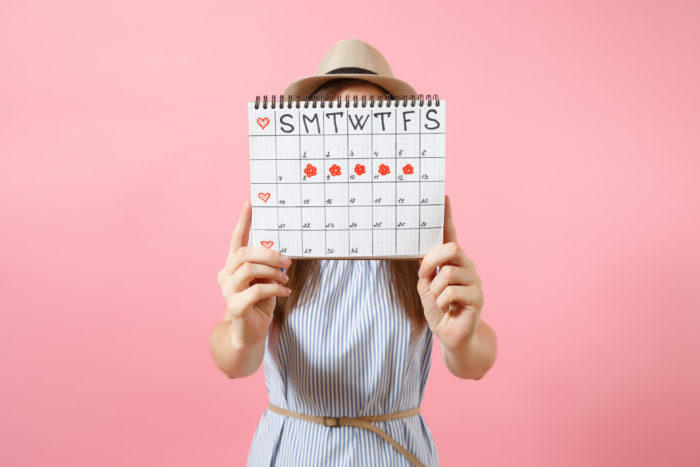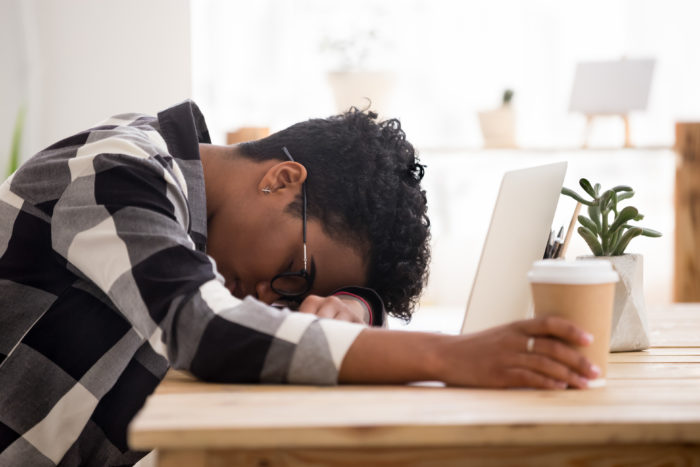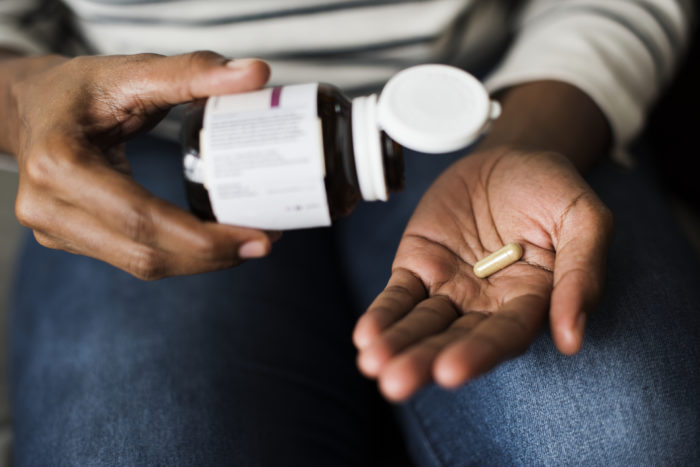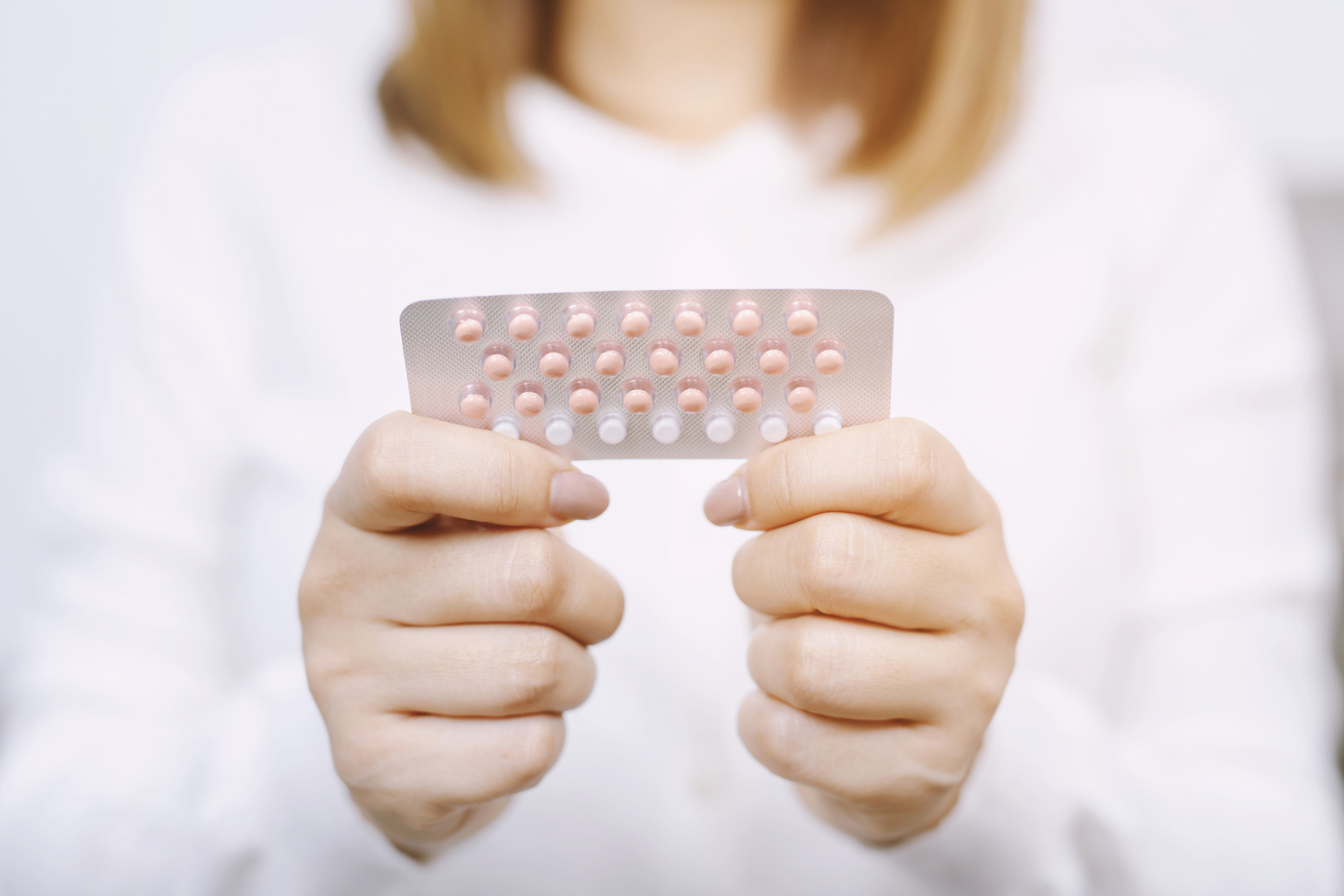Many women need to balance their hormones after they stop taking birth control. Are you one of them? Keep reading to learn my four-step method to get started today!
There are so many reasons why women start taking hormonal birth control. Maybe it’s severe endometriosis, dangerously heavy menstrual bleeding, or even wanting an effective way to prevent pregnancy.
No matter why you started using hormonal contraceptives, once you’re ready to stop, it’s common to run into some issues with your hormones.
Hormonal birth control (like the pill, hormonal IUDs, or the implant) work by shutting down your natural hormone fluctuations. The natural increase and decrease of estrogen and progesterone are instead replaced with a specific dose of synthetic hormones that inhibits ovulation.
The suppression of hormones and the prevention of ovulation is what makes birth control effective. But it’s also behind the need for hormonal balancing after stopping birth control.
In this post, you’ll learn why supporting your hormones after birth control is so important. Plus I’ll teach you my four-step method for getting your hormones back on track once you’ve decided to ditch the pill.
It’s important to talk with your health care provider before you stop your birth control. Don’t just go off it without consulting your prescribing physician first, especially if you started birth control for a specific health condition.
But once you’ve gotten the okay, this article will help you balance your hormones and heal your body from the effects of birth control.
What Happens When Your Stop Hormonal Birth Control
Depending on your reason for stopping hormonal birth control, you might start feeling a lot better once you quit it.
Many women using hormonal contraceptives experience side effects like mood swings, anxiety, acne, and weight gain. And if you’re one of them, getting a reprieve from those unwanted symptoms can be a relief.
Unfortunately, that relief doesn’t always last. Around four to six months after you stop birth control, some women experience what’s known as Post Birth Control Syndrome.
This collection of symptoms can occur for a multitude of reasons after quitting birth control.
Thankfully, if you’re experiencing this hormonal imbalance, you won’t be stuck there forever. AND you don’t need to get back on the pill to find relief.
First, let’s take a look at what happens to your hormones when using hormonal birth control…
A Normal Menstrual Cycle vs a Pill Cycle
In a normal, healthy menstrual cycle, our sex hormones fluctuate throughout the month.
High estrogen levels dominate the follicular phase in the first two weeks of your cycle. After ovulation, estrogen levels are lower, and progesterone spikes. This leaves progesterone as the primary hormone of influence during the luteal phase.
If fertilization of the egg (pregnancy) didn’t occur, both hormones start their decline, bottoming out at the start of your next period. This decline in both hormones is what leads our uterine lining to shed, and is the blood you see when you start your cycle.
But when you’re using birth control, there are no longer any natural ebbs and flows to your natural hormones.
Every day you take a pill, your body is getting a constant stream of synthetic hormones. You no longer have a follicular phase or a luteal phase, or even a real period! (
A “real” period involves ovulation, which is suppressed on hormonal birth control.)
Keep in mind, the suppression of this hormone with birth control is essentially the same thing that happens during pregnancy. So those normal hormone fluctuations that we described won’t occur, because you’re not ovulating.
Why You Need to Balance Hormones After Birth Control
Hormonal birth control shuts down your reproductive system. This can be helpful to dull the symptoms of endometriosis or heavy menstrual bleeding, but it’s not a root cause solution for any hormonal imbalance. And there are potential consequences to solely relying on hormonal birth control as a way to improve these symptoms.
The hormonal variations that normally occur during your cycle are non-existent when you’re on the pill.
The synthetic hormones in birth control do a great job of mimicking your body’s real hormones. After a while, your body gets the signal that it has enough of these sex hormones in circulation and it stops producing its own.
This works out okay while you’re on birth control in most cases. But when you stop introducing those synthetic hormones, your body doesn’t immediately pick up the slack and start producing its own again right away.
Your brain and your ovaries have a delicate communication system that has been offline, and needs time to get back in sync. Many women don’t ovulate right away after stopping their hormonal contraception. And without ovulation, estrogen and progesterone levels get out of balance.
This time lag between stopping birth control and your brain and ovaries communicating properly is behind the symptoms of Post Birth Control Syndrome. The imbalance between estrogen and progesterone that follows is why you need to focus on balancing your hormones after stopping birth control.
Common Symptoms of Imbalanced Hormones
Some women will have no problem transitioning off of hormonal birth control. But if you’re not one of those lucky few, you might experience unpleasant symptoms after ditching the pill.
Here are some of the common symptoms of imbalanced hormones after stopping birth control:
If you’ve recently stopped birth control, these symptoms are some of the first signs that your hormones are in need of attention and care.
But jumping back on birth control isn’t the best solution. There are risks to being on hormonal birth control for an extended period of time. And there are natural ways to help your body get back into balance and get rid of those frustrating hormonal symptoms.
Keep reading to learn my four-step plan for balancing hormones and reducing your symptoms after birth control!
Four Steps To Balance Hormones After Birth Control
Now that we’ve covered WHY you need to balance your hormones after stopping birth control, let’s get into the good stuff – the HOW.
The most important thing to remember when you’re working to balance hormones is that it can take time.
Hormones take around 3-4 months to react to any changes you’ve made, good or bad. So when you’re implementing these steps, be patient. Your body will need time to respond to your efforts.
Walking through this four-step process WILL benefit your hormones in the long run. And you’ll likely see changes in your overall health in an even shorter amount of time too.
These steps are like the ones that I use with my one-on-one clients and the women in my Get Your Period Back program. I’ve had great success in helping these women rebalance their hormones after birth control so I know you can see improvements too!
Ready to start balancing your hormones? Let’s go!
Step 1: Nourish Your Body
Step 1 for balancing your hormones after birth control is a simple, but often overlooked, one – nourish your body.
Fueling your body with enough calories and the optimal macronutrient ratio is critical to healing your hormones. Keeping your blood sugar stable will do wonders for your hormone health. Imbalances in your insulin response can stop hormones from triggering ovulation and a normal cycle.
Chronic undereating, even if you’re not doing it on purpose, is often behind many of the hormonal problems I see in my practice.
And when you combine undereating with recovering from birth control, your hormones don’t stand much of a chance.
Reproduction is an energy-expensive process. If your body doesn’t have enough energy to promote fertility, balancing your hormones after birth control will be a difficult task.
Using a calorie needs calculator, like this one, to determine your minimum caloric need can be a helpful starting point when trying to eat more.
Also, it’s not just how much you eat that matters. What you eat impacts your hormonal health and can help your body recover faster from birth control use.
Sex hormones are made primarily from cholesterol which is produced from eating fat
. And when you’re not consuming enough fat to produce adequate cholesterol, your body can struggle to make an appropriate amount of these hormones.
Consuming fat-containing foods like beef, lamb, poultry, coconut, avocado, salmon, or eggs at every meal will go a long way in helping to rebalance your hormones.
When it comes to your diet, Gut Health Matters Too
Did you know that your gut health plays a big role in how well you metabolize hormones, especially estrogen?
There are certain beneficial bacteria in your gut, known as the estrobolome, that help remove used estrogen from your body.
Synthetic estrogen bombards your body – and especially your gut – when you’re using estrogen-containing birth control. When you compare that to how estrogen in a normal cycle changes over time, the constant stream of estrogen in birth control can be a lot for your body to handle.
If you don’t have enough estrogen-metabolizing bacteria in your gut, your body can have a hard time getting rid of those excess hormones, even once you stop using birth control.
Integrating probiotics and prebiotics into your diet along with a professional quality calcium d-glucarate supplement will do wonders to support your gut’s estrogen metabolism capabilities.
Step 2: Add in Supplementation
Once you’ve spent some time focusing on nourishing your body, you’re ready to move on to Step 2 to balance your hormones after birth control – evidence-based supplementation.
I intentionally place supplementation secondary to dietary changes because you can’t out-supplement undereating, poor blood sugar control, or malnourishment.
With that being said, supplements do play an important role in rebalancing hormones and reducing your symptoms post-birth control.
Hormonal birth control is notorious for depleting the body of key nutrients. Many of these nutrients play an important role in the health and vitality of your reproductive system.
Without improving your nutrient status, achieving hormonal balance after quitting birth control can be difficult.
Here are some of the key vitamins and minerals to focus on to help balance your hormones.
B Vitamins
Studies have shown that women using birth control can experience a sharp decline in their levels of B vitamins, particularly vitamin B12 and vitamin B6.
Important B vitamins to supplement with are cobalamin (B12), pyridoxine (B6) folate (B9), biotin (B7), and riboflavin (B2).
Bioindividuality is so important when supplementing with B vitamins. Here’s an article I wrote that can help you figure out which B vitamins would be right for your unique genetic needs.
Vitamin C
If you’ve been using birth control that contains synthetic estrogen, supplementing with Vitamin C is going to be important.
The high levels of estrogen in birth control are associated with a decrease in Vitamin C levels in women who use this form of contraceptive.
To boost your Vitamin C levels after birth control I recommend using a Liposomal Vitamin C for best absorption and minimal gut effects. (Unabsorbed vitamin C in the gut can cause diarrhea!)
Minerals
Your body’s cellular processes rely on minerals to help it carry out daily functions. And when these minerals get depleted from birth control use, your body has a hard time functioning optimally.
But, it looks like birth control doesn’t deplete all mineral levels. One study showed that copper, iron, calcium, and cadmium levels were all higher in women using birth control than women who were not.
Step 3: Be Intentional About Reestablishing Your Cycle
Once you’ve focused on dialing in your diet and nutrient status you can move onto Step 3 – working to reestablish your cycle.
This step is only going to be successful if you’ve put in some dedicated effort to the first two steps.
It can be tempting to skip straight to this step. But laying the foundation of nourishing your body and improving your nutrient status is critical in reestablishing your hormonal health.
There are a few ways that I like to encourage women to help their bodies get back into a normal hormonal rhythm.
The practice of seed cycling can be helpful for building a cyclical hormone patter again after birth control.
You can also focus on minimizing your exposure to xenoestrogens that are commonly used in skincare, home cleaning products, and plastics. These chemicals mimic estrogen in our bodies and can throw off your own hormone production.
Your body wants to be healthy and in balance. And when you give it enough space (and a little targeted coaxing) your body will get back into balance once again.
Step 4: Team Up with a Practitioner
If you’ve made it all the way to Step 4 (and have implemented the first three steps for at least a few months) but still haven’t seen any hormonal improvements, you’re not alone.
Sometimes it takes a little targeted support from someone who has experience helping women like you.
Enlisting the help of a practitioner doesn’t mean you’ve failed. It means that you’ve done everything you can on your own, or you want to make sure what you’re doing is optimal for your unique body… and you’re wise enough to know when you need an expert’s point of view!
I have experience helping hundreds of women achieve hormone balance after stopping birth control, and I’d be honored to use my expertise to help you too.
This training will show you the four biggest mistakes I see women making when trying to heal their hormones. Plus it will guide you through my signature protocol for holistic and effective hormonal recovery.
Either way, I’m on your team to help you find true hormonal balance and recovery from birth control.
Now you tell me, what’s worked for you to help balance your hormones after coming off birth control? Share your experience in the comments!
A Note for Our Readers
I no longer offer 1:1 nutrition or functional health services, and I’m not accepting new clients for digestive or hormone-related support. This blog remains published as a helpful resource for women navigating these health challenges — especially those looking for clarity around their symptoms and well-being.
Today, my work is dedicated to helping Health Coaches, Practitioners, and Wellness Entrepreneurs grow profitable, sustainable businesses through private practice coaching and mentorship.
If you’re a wellness professional who’s ready to grow a thriving, values-aligned business without burning out, click here to learn more about my coaching programs.
And if you’re ready to build the kind of online health business that nourishes you financially, emotionally, and energetically, check out my signature program, the Nourished Business Accelerator™.
Thank you for being here and I wish you the best on your journey.
This post may contain affiliate links. If you click on a link and make a purchase, I may receive a small commission.
Looking for more? Check out these great posts:
Share this with someone who needs it!









+ show Comments
- Hide Comments
add a comment